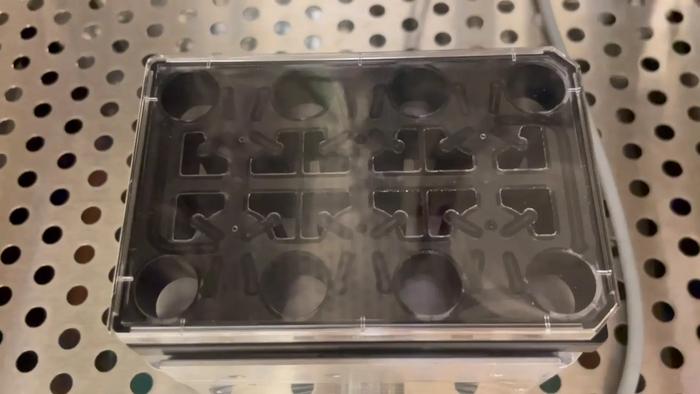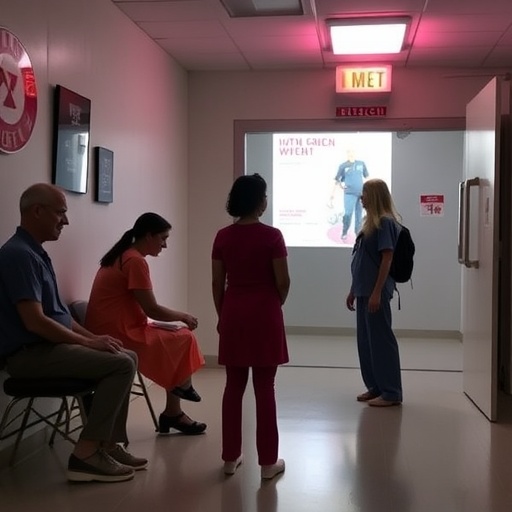Imagine a device smaller than a toddler’s shoebox that can simulate any human disease in multiple organs or test new drugs without ever entering — or harming — the body.

Credit: Northwestern University
- Device can manipulate which organ is driving a disease to study its downstream effects
- Can serve as intermediate step between animal studies and clinical trials to test new drugs
- ‘We wanted to make it as easy as using a smartphone’
Imagine a device smaller than a toddler’s shoebox that can simulate any human disease in multiple organs or test new drugs without ever entering — or harming — the body.
Scientists at Northwestern University have developed this new technology — called Lattice — to study interactions between up to eight unique organ tissue cultures (cells from a human organ) for extended periods of time to replicate how actual organs will respond. It is a major advancement from current in vitro systems, which can only study two cell cultures simultaneously.
The goal is to simulate what happens inside the body to analyze, for example, how obesity might affect a particular disease; how women metabolize drugs differently than men; or what might be initially driving a disease that eventually impacts multiple organs.
“When something’s happening in the body, we don’t know exactly who’s talking to whom,” said lead scientist Julie Kim, professor of obstetrics and gynecology at Northwestern University Feinberg School of Medicine. “Currently, scientists use dishes that have one or two cell types, and then do in-depth research and analysis, but Lattice provides a huge advancement. This platform is much better suited to mimic what’s happening in the body, because it can simulate so many organs at once.”
A study detailing the new technology will be published Oct. 3 in the journal Lab on a Chip.
Choose-your-own-adventure disease simulator
The microfluidic device has a series of channels and pumps that cause media (simulated blood) to flow between the eight wells. A computer connected to Lattice precisely controls how much media flows through each well, where it flows and when. Depending on which disease or drug the scientist wants to test, they can fill each well with a different organ tissue, hormone, disease or medication.
For instance, Kim’s lab is using Lattice to study polycystic ovarian syndrome (PCOS), which is a condition characterized by an imbalance of reproductive hormones and metabolism problems. Scientists still aren’t sure why or how PCOS develops. Although it affects the ovaries, many other organ systems in the body are affected.
“What we can do with Lattice is start manipulating and controlling which organ is driving the disease,” Kim said. “So, in one experiment, we might start with a PCOS ovary to see how it impacts the liver or muscles. Another experiment might examine if it is the high insulin associated with the disease that’s driving the different organ systems to behave erratically. We can control the tissues and order them in specific ways.”
A fail-safe check before clinical trials
The current method of testing new drugs begins in the lab in a dish (in vitro), then is tested in animal models, and next moves to human clinical trials.
“There’s nothing in between animal testing and human clinical trials, and we find that many drugs fail in humans,” Kim said. “Lattice could be that intermediate step between animal studies and clinical trials, because we can test drugs that have passed animal studies to see if they’re safe for human tissues. It’s one more fail-safe check before we put them in bodies.”
Lattice can test longer than other in vitro systems
Standard primary cell cultures in current in vitro dishes don’t survive long, Kim said. But Lattice was designed to provide fresh media (simulated blood) to the cultures and to eliminate waste through the pumping of media through each of the eight wells so that the tissues survive longer. The scientists have tested the system for up to 28 days and hope to go longer, Kim said.
“For instance, obesity is a major risk factor for endometrial cancer,” Kim said. “We could never study the impact of risk factors in a dish because they require long-term cultures. In Lattice, we can study how fat directly affects the endometrium for a longer period of time and study some early changes that occur in endometrial cells.”
User-friendly for broad research use
Lattice is the second-generation version of EVATAR, whose creation was led by Teresa Woodruff, a former Northwestern faculty member and co-author on the current study. EVATAR is a miniature female reproductive tract that enables scientists to conduct much-needed testing of new drugs for safety and effectiveness on the female reproductive system. Lattice was created to study many more diseases in both men and women. It is cheaper and more user friendly, which Kim said she hopes will allow for broad use in the research and pharmaceutical fields.
“Since EVATAR, we wanted to make something user friendly, so you don’t need engineers on hand to assemble or troubleshoot it,” Kim said. “We wanted to make it as easy as using a smartphone — take it out of the box, turn it on and use it — so researchers can get data and not spend too much time on how to work it in their lab.”
The study, “A New Tissue-Agnostic Microfluidic Device to model physiology and disease: The Lattice Platform,” was conducted in collaboration with scientists from University of Illinois Chicago, Rutgers University and Michigan State University. Northwestern’s Hannes Campo, a postdoctoral fellow in Kim’s lab, is the study’s first author.
Journal
Lab on a Chip
DOI
10.1039/D3LC00378G
Article Title
A New Tissue-Agnostic Microfluidic Device to model physiology and disease: The Lattice Platform
Article Publication Date
3-Oct-2023




